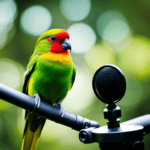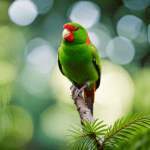Is My Kakariki Male or Female? If you’re curious about these vibrant and playful creatures, our comprehensive guide will help you understand how to tell if a kakariki bird is male or female. Distinguishing between the genders is crucial for various reasons, such as creating compatible breeding pairs, monitoring their health and development, and providing appropriate care. In this article, we’ll explore the various physical and behavioural cues that can be used to differentiate between male and female kakariki birds and other important factors to consider. Let’s get started on discovering the gender of your delightful feathered friend!
Physical Differences between Male and Female Kakariki Birds
Kakariki birds exhibit a range of physical characteristics that can help distinguish between males and females. Here are some key traits to look out for:
| Characteristic | Males | Females |
|---|---|---|
| Plumage Colouration | Often have brighter, bolder colours, especially on their head and neck. | Hues may be slightly muted compared to male counterparts. |
| Size | Tend to be larger and more robust, with a broader and more muscular head. | Smaller and more delicate in overall appearance. |
| Beak Shape | The beak is generally longer and wider, with a more pronounced hook at the end. | The beak is shorter and more slender, with a slight curve at the end. |
Not all physical traits are definitive indicators of gender, as there can be variation within the same sex. For example, some females may have brighter plumage or larger beaks than males.
However, by observing a combination of physical traits, you can generally make a confident assumption about the gender of a kakariki bird.
Behavioural Differences between Male and Female Kakariki Birds
Aside from physical characteristics, the behaviour of kakariki birds can also be a helpful indicator of their gender.
Mating behaviours: Male kakariki birds are typically more aggressive and showier in their displays when attempting to attract a mate. They may also perform courtship dances and offer food to females. Conversely, females tend to be more selective in choosing a mate and may show more interest in inspecting the nesting site.
Territoriality: Male kakariki birds tend to be more territorial and may display dominance over their territory by chasing away other birds and animals. Conversely, females may be more social and form groups with other females and juveniles.
Vocalizations: Male kakariki birds may have louder and more varied vocalizations compared to females, especially during breeding season. Females may also vocalize, but their calls tend to be softer and more repetitive.
Playfulness: Kakariki birds are known for their lively and playful personalities, but this trait may be more common in males. Male kakariki birds may be more adventurous and enjoy exploring their environment, while females may be more cautious.
Expert Tip:
Observing mating behaviours can provide valuable clues to the gender of a kakariki bird, particularly during breeding season. However, it is important to note that individual personalities can vary, so it is best to use behavioural cues in combination with physical characteristics for more accurate gender identification.
Age and Maturity as Indicators of Kakariki Gender
Another important factor to consider when determining the gender of kakariki birds is their age and level of maturity. As with many bird species, male and female kakariki birds can look very similar in their youth, making it challenging to determine their gender accurately.
However, as kakariki birds mature, they undergo physical and behavioural changes that can be used as indicators of their gender. These changes occur at different stages of development, and knowing what to look for can be useful in identifying the sex of your birds.
| Age Range | Physical Changes | Behavioural Changes |
|---|---|---|
| 0-6 Months | No clear physical differences between males and females | No significant behavioural differences between males and females |
| 6-12 Months | Male birds may begin to show more vibrant plumage coloration, especially on the head. Females may have a slightly smaller size and a more rounded beak shape. | Male birds may become more vocal and exhibit territorial behaviour, while females may become more playful and social. |
| 1-2 Years | Male birds typically have a larger size, a more angular beak shape, and more prominent head feathers than female birds. | Male birds may display courtship behaviour towards females, while females may be more protective of their nests. |
It’s important to note that these changes can vary among individual birds and may not always be reliable indicators of their gender. However, observing the physical and behavioural changes that occur as your kakariki birds mature can be a helpful tool in determining their sex.
Genetic Testing for Kakariki Birds
If you want to determine the gender of your kakariki birds with absolute certainty, the most reliable method is through genetic testing. This involves taking a sample of the bird’s DNA, usually by collecting a sample of blood, feathers, or egg yolk, and sending it to a laboratory for analysis.
The laboratory will then extract the bird’s DNA from the sample and examine specific chromosomes or genes that are known to be associated with gender. By comparing the bird’s DNA to known sequences, the laboratory can determine whether the bird is male or female with a high degree of accuracy.
Genetic testing is particularly useful in cases where it is difficult to determine the gender of the bird through physical or behavioral traits alone. For example, some mutations or markings can make it difficult to determine the gender of a kakariki bird, especially in young birds or those that have not yet reached sexual maturity.
However, genetic testing does come with certain disadvantages. It can be expensive, with some tests costing hundreds of pounds. Additionally, it requires specialist equipment and expertise to perform the analysis, so it may not be possible to carry out the test locally.
If you are considering genetic testing as a method of determining the gender of your kakariki birds, it is important to research the available laboratories carefully and ensure that they have experience with avian DNA testing. You should also be aware that in some cases, the process of collecting a sample for DNA testing can be stressful for the bird, so it is important to take good care when collecting the sample.
Expert Tips for Identifying Kakariki Gender
Identifying the gender of kakariki birds can be a challenge, but with the right knowledge and observations, it can be done accurately. Here are some expert tips to help you determine the sex of your kakariki:
- Observe their head shape: Male kakariki birds tend to have a rounder head while females have a flatter head shape. This is due to the presence of the cranial bump found on male birds.
- Look at their beak size: Female kakarikis typically have a longer and thinner beak compared to males with a shorter and wider beak.
- Listen for different vocalizations: Males tend to have a more complex and varied vocalization compared to females, who have a simpler call.
- Observe their behaviour during breeding season: Male kakarikis usually perform courtship displays or singing during breeding season while females tend to exhibit more territorial and aggressive behaviour.
- Check their leg size: In general, male kakarikis have thicker legs than females, but this can vary by subspecies. It’s worth noting that leg thickness alone is not a reliable indicator of gender.
Remember that these observations are most accurate when done on adult birds in non-breeding condition. Additionally, it’s important to observe your kakariki over time as some characteristics can change depending on age, health, or environmental factors.
Common Misconceptions about Identifying Kakariki Gender
There are several common misconceptions when it comes to identifying the gender of kakariki birds, which can lead to inaccurate assumptions and confusion. Here are some of the most widespread myths:
| Myth | Truth |
|---|---|
| Kakariki birds can change their gender. | Once a kakariki bird’s gender is determined, it cannot change. Gender is determined by genetic make-up and cannot be altered. |
| All male kakariki birds have red crowns. | While many male kakariki birds have red crowns, this is not a reliable indicator of gender as some females may also display this characteristic. |
| One can determine kakariki gender based on behaviour alone. | While behaviour can provide some clues about gender, it is not a definitive indicator. Other factors such as physical traits and DNA testing should also be considered. |
It’s important to be aware of these misconceptions and rely on accurate methods for identifying the gender of kakariki birds. By focusing on reliable indications such as physical traits, behaviour, age, maturity and genetic testing, you can determine the gender of your kakariki bird with confidence.
Breeding and Pairing Kakariki Birds
Breeding kakariki birds can be a rewarding experience for bird enthusiasts, but it requires careful planning and preparation. Here are some considerations and strategies for breeding and pairing kakariki birds:
| Consideration | Strategy |
|---|---|
| Selecting compatible mates | It is important to choose kakariki birds that are of appropriate age and health, and have compatible temperaments. Observe them carefully to ensure they get along before pairing them. |
| Creating a suitable nesting environment | Kakariki birds require a nesting box that is large enough for them to move around comfortably and lay eggs. It should be filled with suitable nesting materials, such as shredded paper or wood shavings, and placed in a quiet location away from disturbances. |
| Caring for eggs and offspring | Once the eggs are laid, they should be incubated for around 21 days until they hatch. The parents will take care of the offspring, but it is important to provide them with a healthy diet and clean environment. The offspring should be left with the parents until they are independent enough to fend for themselves. |
When breeding kakariki birds, it is important to remember that they can breed multiple times per year and produce several offspring in each clutch. Giving the birds a break between breeding cycles is advisable to prevent excessive strain on their bodies.
Tips for Successful Breeding
Here are some additional tips for successful breeding and pairing of kakariki birds:
- Provide a nutritious diet that is rich in vitamins and minerals.
- Ensure a clean and hygienic environment to prevent the spread of disease.
- Observe the birds regularly to ensure they are healthy and happy.
- Consult with a veterinarian or experienced breeder for advice and guidance.
With patience and care, breeding and pairing kakariki birds can be a rewarding experience that can produce healthy and happy offspring.
Is My Kakariki Male or Female? FAQ’s About Kakariki Gender
Q: Can you determine the gender of a Kakariki bird just by looking at its plumage?
A: While the colouring and patterns of a Kakariki bird’s plumage can provide some clues, it is not a reliable method for determining gender as both male and female Kakarikis can have similar feather patterns and colours.
Q: Do male and female Kakariki birds have different vocalizations?
A: Yes. Male Kakariki birds tend to have a more complex vocalisation repertoire, including louder calls and whistles, particularly during mating season. Females typically have fewer and softer calls, but this may vary between individuals.
Q: At what age can you tell the gender of a Kakariki bird?
A: Sexually dimorphic traits, such as the size of the cere (the fleshy part above the beak) and the colour of the feathers around the vent, begin to appear at around 6 months old, but it may take up to 12 months before they are fully developed.
Q: Can genetic testing be done to determine the gender of Kakariki birds?
A: Yes. Genetic testing, such as DNA sexing, is a reliable method for determining the gender of Kakariki birds, although it may be costly and time-consuming.
Q: How do I ensure successful pairing and breeding of my Kakariki birds?
A: It is important to select compatible mates based on factors such as age, behaviour, and physical condition. Provide a suitable nesting environment, including a clean and spacious nest box, and ensure they have access to a variety of healthy foods. It is also recommended to consult with experienced breeders or avian veterinarians for additional guidance.
Q: Are there any common misconceptions about identifying the gender of Kakariki birds?
A: One common myth is that males are always more colourful than females. However, this is not always the case, as both males and females can have vibrant plumage. It is important to rely on multiple indicators, such as behaviour and physical characteristics, to determine their gender accurately.
Q: What should I do if I am still unsure of the gender of my Kakariki bird?
A: If you are having difficulty determining the gender of your Kakariki bird, it is recommended to consult with an experienced avian veterinarian or bird keeper. They can provide advice and expertise to help you accurately identify the gender of your bird.



Have comments or questions about this article? Then get involved!
Spotted an error or something we have missed? Let us know